- Author Jason Gerald [email protected].
- Public 2023-12-16 10:50.
- Last modified 2025-01-23 12:04.
Parasites or worms in the digestive tract are common in kittens and adult cats. This disgusting pest can arise due to several things. Kittens can get worm eggs from their mother's milk. Young cats can be infected with hookworm through the skin, and tapeworm through fleas, rodents, and rabbits that are infected and ingested by cats. Since worms are so common in cats, it's important that you recognize the signs that your cat has worms so that you can provide them with the treatment they need as quickly as possible.
Step
Method 1 of 2: Looking for Physical Symptoms that Cats have Worms

Step 1. Notice if the cat's belly looks distended
Cats that have a lot of worms in their bodies are more likely to have a distended stomach, but have less fat in the vertebrae or hips. The cat's belly will look bloated, round, and full. Oftentimes, this swelling occurs in the cat's lower body so that the cat can look like she is pregnant. The difference between a pot belly and a fat cat is that the rest of the cat's body looks thin.
Roundworms are the main cause of belly bloat in cats, although other types of worms also cause this symptom
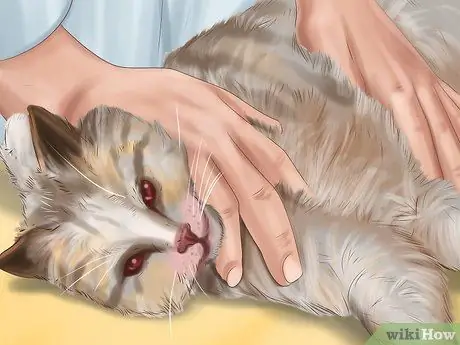
Step 2. Check the cat's fat pads
When you stroke a healthy cat's vertebrae, you'll be able to feel lumps along the vertebrae, but they won't feel sharp. This is because there is a fat pad on the cat's bones. Cats that have lots of worms will not have these fat pads. When you stroke the cat's back and hips, the cat's bones will feel sharp.
Body "conditioning" is a way of assessing the level of fat covering a cat's bones. Body parts such as the vertebrae, thighs, and hips are good areas to do this

Step 3. Look at the condition of your cat's coat
The body's digestive parasites steal a lot of nutrients from a cat's diet. This means that your cat won't be getting the vitamins, minerals and protein it needs to keep its coat healthy. Pay attention if you see:
- Dull fur.
- Non-shiny hair.
- Tangled fur.
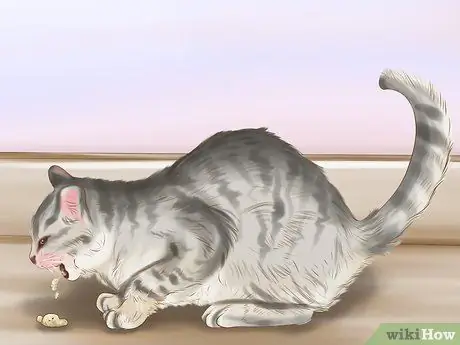
Step 4. Watch if the cat vomits or has diarrhea
Worms can irritate the cat's stomach and digestive tract, causing the cat to have diarrhea and vomiting. Large numbers of worms can damage the stomach and cause severe and potentially life-threatening vomiting. Cats can even regurgitate a bundle of worms that look like squirming spaghetti.
If your cat starts vomiting uncontrollably, take her to the vet's office as soon as possible

Step 5. Look at the color of the cat's gums
Some types of worms, especially hookworms, can cause stomach bleeding, so the cat will experience slow but steady bleeding. This bleeding can cause anemia in the cat, which makes the cat look weak and weak if the bleeding is serious enough. For kittens, this can be deadly.
You can identify the symptoms of anemia by lifting your cat's lips and paying attention to their gums. Healthy gums will be pink. If your cat is anemic, their gums will be white, gray, or a pale pink
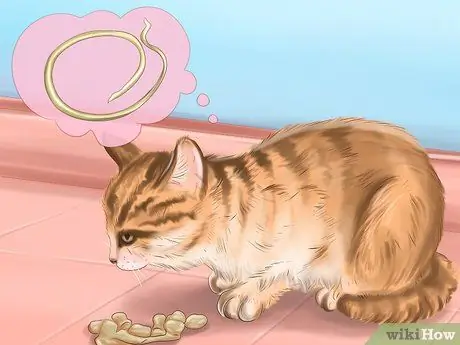
Step 6. Watch for signs of a dewormed kitten
Kittens with worms will appear weak and uninspired. This means that the kitten is not developing like its siblings. Kittens will appear smaller, less energetic, have a dull coat, have a distended belly, and have less fat around the ribs and spine.
- If you don't have other kittens to compare with, it will be more difficult to judge. However, a healthy cat should look shiny, playful, plump, and have a soft, shiny coat.
- A large number of worms in kittens can have a lifelong impact, causing a cat's health to be suboptimal throughout its life.
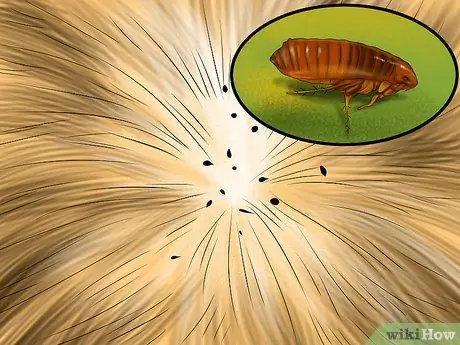
Step 7. Check for fleas on the cat
This measure is relevant because fleas can carry tapeworm eggs. While grooming themselves, the cat will eat the fleas in its fur, allowing tapeworm eggs to enter the cat's system.
- It will be easier to find flea droppings than the lice themselves. Flea droppings are dried blood secreted by fleas and are often seen in the fur of animals infested with fleas.
- To look for flea droppings, comb the fur in the opposite direction and look for small spots near the roots of the cat's fur.
- To make sure that the spots you find are flea droppings (not dust or dandruff), take a piece of white wet tissue and place the dirt on it. Because it comes from dried blood, flea droppings will leave a red or orange stain when they come into contact with a wet tissue.
- If you find fleas or their droppings, you'll need to get rid of fleas on your cat and the environment around you (such as your home and bedding).
Method 2 of 2: Identifying the Type of Worm
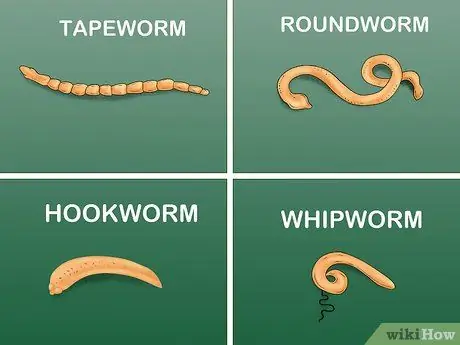
Step 1. Understand why you need to identify the type of worm
If you suspect your cat has worms, the next step is to identify the type of worm. This step will let you know what medications are effective for getting rid of the worms.
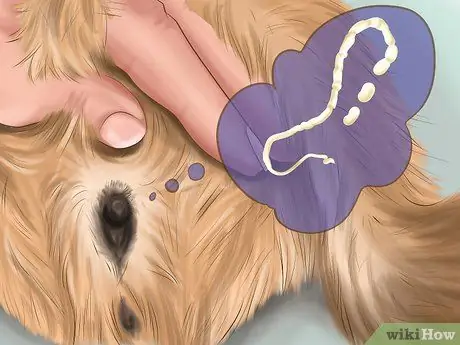
Step 2. Find a flock of migrating tapeworm eggs
Look at the bottom of the cat's tail. A collection of tapeworm eggs will migrate to the cat's anus and become trapped in the fur around the rectum. Worm eggs are ivory white in color and are described as rice, cucumber seeds, or sesame seeds.
- Worm eggs can get stuck in a cat's bedding, so you should also check for them.
- If you find worm eggs that migrate, take your cat to the vet for treatment for the tapeworm infection.

Step 3. Examine the cat's feces for tapeworms
This method is easier to do if you use a sandbox. Check for worms in the stool. Sometimes you will see worms immediately on the surface of cat litter, but you will most likely need to wear plastic gloves and a disposable kit to check for worms in cat litter.
- The tapeworm is ivory white in color, looks flat, and is segmented. It is about 10 to 70 cm long.
- Dipylidium caninum: Cats can acquire this tapeworm by eating fleas that are infected with tapeworm eggs.
- Taenia taeniaeformis: Cats can acquire this tapeworm when hunting, catching, and eating rodents infected with this type of tapeworm.
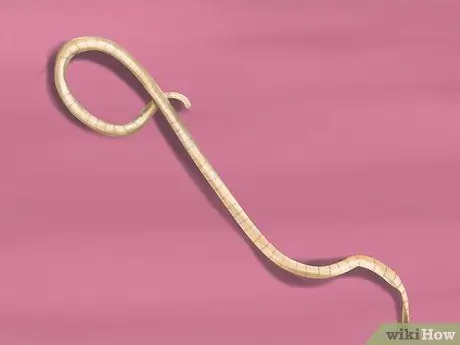
Step 4. Identify roundworms
Roundworms are the most common type of worm and look like spaghetti or noodles. Normally, roundworms are about 5 to 10 cm long. There are two different types of roundworms, and cats can get them in a number of ways:
- Toxocara cati: These worms can be acquired through mother cat's milk, and most kittens are infected from birth. This worm is the cause of distended stomachs in kittens and makes cats vomit and have diarrhea.
- Toxascaris leonine: This roundworm is acquired when in contact with other infected cats or rodent feces. These worms can sometimes be seen in cat vomit or feces.

Step 5. Identify the hookworm
Hookworms are small (0.5 to 1 cm), curly worms with hook-shaped mouths. These worms are very difficult to see with the naked eye. Ancylostoma duodenalis can be found in mother cat's milk, although kittens can also become infected with this worm by walking on dirty and infected bedding.
The mouth, which is shaped like a tooth, attaches to the small intestine and secretes anticoagulants that cause blood to leak into the stomach. Infected cats will be anemic, appear weak, and do not grow well
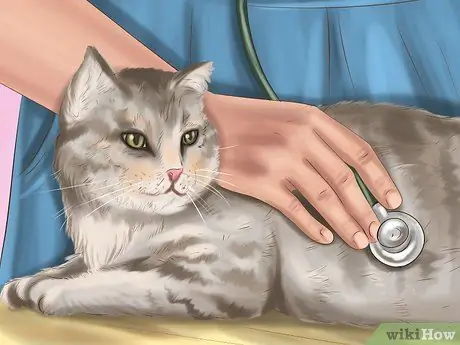
Step 6. Ask your vet to check for liver flukes in your cat
Heartworms are more common in dogs than in cats. Even so, it is still possible for cats to become infected. These worms are found in the blood vessels, not in the intestines. This means that you should see your vet to check if your cat is infected with this type of worm.
Dirofilaria immitis: An infected mosquito can transmit dirofilaria eggs in the cat's bloodstream. Symptoms are not specific, namely loss of energy, weight loss, and cough. Unfortunately, some cats do not show any symptoms and die suddenly, due to blockages in the main blood vessels in the heart
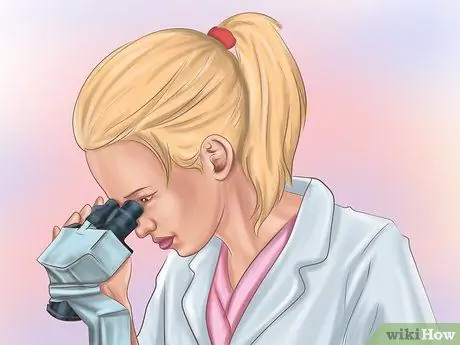
Step 7. Let the vet take a stool sample for analysis
The best way to check for worms (excluding liver flukes), before they pose a higher health risk, is to take a fresh sample of cat litter to the vet. Adult worms will lay eggs while living in the cat's digestive tract. These eggs will be constantly (but not always) passed through the cat's feces and can be seen after special preparation and examination under a microscope.
- The eggs of different types of worms will have a different physical appearance, making it easier for you to identify them.
- If the examination of the cat and its feces does not produce any results, it does not mean that your cat does not have worms. This means that no worms are removed from the body. Some cats can host large numbers of worms and not excrete any of them. The only way to reassure yourself is to take a cat litter sample to the vet for examination.
Tips
- Knowing the types of worms in the cat's body is not trivial because different types of worms require different types of anthelmintics (drugs that can kill worms) as well. However, as a first act, it's best if you as a cat owner already suspect if your cat has worms.
- When identifying worms in a cat's body, it's best to know that your cat is likely to be infected with one of the worms.
- Cats with distended stomachs, little body fat, and have not been treated for worms for the past 6 months are suspected of having large numbers of worms. However, health problems can also cause these symptoms. So, if you have any doubts, consult a veterinarian.
Warning
- Apart from heartworms, there is no preventative measure that can be taken to treat helminth problems other than minimizing your cat's exposure to the infection.
- Identifying if your cat has worms, and the types of worms they have, will help your kitten or adult cat live a healthy life. In addition, some types of worms can also be transmitted to humans, especially children who do not like to wash their hands after playing with cats. With a little attention to cat health and litter box hygiene, and by having a fecal check on your cat once a year, you can keep your cat and home worm-free.
- Always wash your hands-and have children wash theirs-after handling a cat with an unknown worm infection status. Although they cannot live in the human intestine, cat worms can enter the skin and cause sores, especially if the worms creep into the eyes.






